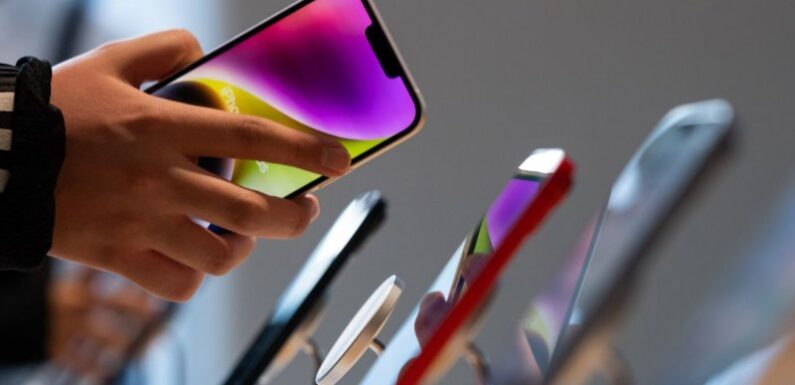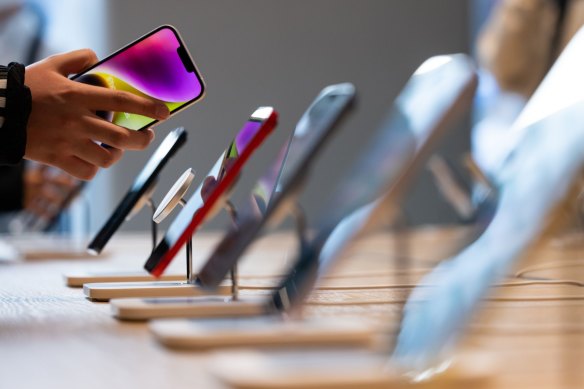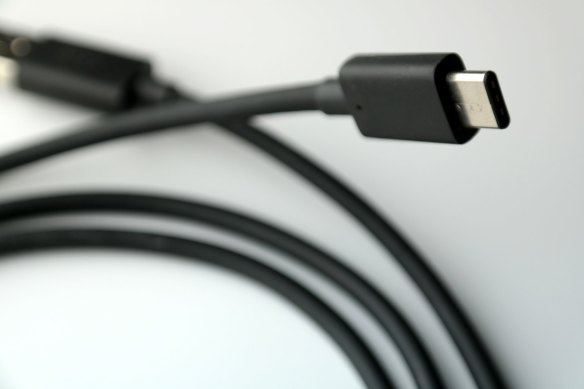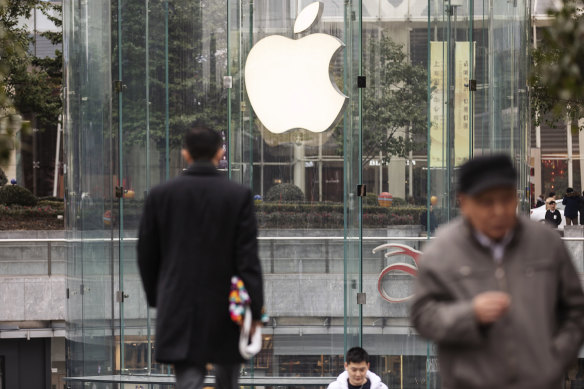
Save articles for later
Add articles to your saved list and come back to them any time.
Every household has that box, under the stairs or in the garage, filled with a tangle of cables and a mishmash of charging plugs. This mess of copper and plastic is the final resting place for wires and old phones that have not been used for years.
Many cables lie abandoned for so long their original use has been forgotten. Yet the wires remain, just in case someone, one day, can remember what they were used for.
Apple’s new phone will be released on Wednesday morning.Credit: Bloomberg
Those boxes could be about to get even more cluttered. On Wednesday morning AEST, Apple will reveal its new smartphone line-up, launching the iPhone 15 and iPhone 15 Pro. The phones will, undoubtedly, be hailed by Apple as faster, smarter and more powerful than its previous generation.
But one update to the new phones was beyond Apple’s control. The US tech company will be changing its “Lightning” charging wire and port – a technology unique to its devices – to another type of cable, known as “USB-C”.
While the tweak may seem innocuous, it has been the subject of furious debate and expensive lobbying by Apple for years, as the tech giant battled mandarins in Brussels who had launched a crusade against technology “e-waste”.
Last year, Brussels confirmed new rules that will force technology companies to adopt a common charging standard, picking USB-C, from 2024.
Officials at the time said, under the new rules, consumers would no longer need a different charger every time they purchase a new device, saying they would be able to use one single charger “for a whole range of small and medium-sized portable electronic devices”.
They argued chargers generated 11,000 tonnes of e-waste annually in the bloc, costing consumers €250 million ($418 million) each year. Since then, Apple has begrudgingly accepted that diktat. All the new phones in its iPhone 15 line-up are now expected to require a USB-C charger.
But experts say the move could irk some consumers by yet again making former charging hardware redundant, just as Apple’s revenues are falling.
Paolo Pescatore, an analyst at PP Foresight, says he expects to see “some backlash”, while Ben Wood, chief analyst at CCS Insight says: “The expected shift to USB-C could generate some friction for Apple customers who already have proprietary ‘Lightning’ cables and docks around their homes.”
All the new phones in its iPhone 15 line-up are now expected to require a USB-C charger.
While Apple’s iPhone 15 will feature a few new innovations, such as a zoomable periscope camera, the launch comes at a delicate time for Apple.
The $US2.7 trillion technology company has endured its longest period of revenue decline since 2016 and recently reported iPhone sales had fallen by just over 2 per cent in the three months to June.
Last week, more than $US200 billion was knocked from its market value, following reports China is banning the use of iPhones by government officials. China is a major driver of sales for Apple, while it is also crucial for its manufacturing.
Aside from the switch to new charging, Apple’s iPhone 15 range is likely to be a modest upgrade compared to previous years.
Although Apple will be keen to portray the switch as just one of its new iPhone innovations, last year it was fuming at the EU decision. “Obviously we’ll have to comply, we have no choice,” Greg Joswiak, Apple’s head of marketing, told Sky News last year. “The Europeans are the ones dictating the timing,” he said at the time.
In fact, Apple has spent years lobbying against the EU’s efforts.
Brussels first called for phone and laptop chargers to meet a common standard back in 2009. Back then, there were dozens of competing charging ports that were useless on rival brands. Apple signed up to an industry group that promises to work towards a single charging standard.
However, in 2012, it introduced its unique Lightning cable, which it is still using years later. Now, there are only three main charger types in Europe.
An 88-page report in 2019, commissioned by Apple itself, claimed consumers would face costs of €1.5 billion if they were forced to change chargers as a result of the reforms.
The report claimed: “The common charger would yield, at most, only limited environmental benefits.”
As of this year, there are roughly 1.5 billion iPhones in use worldwide, all of which use the company’s Lightning cables.
Apple is expected to make the swap from Lightning globally, not just in Europe.
Buyers who have relied on the same Lightning connector for many years may also find they have to buy a new wall power adapter.
Apple has had a rocky week leading into its next product release.Credit: Bloomberg
To save on packaging, iPhones no longer come with a charging cable in the box. Its AirPod wireless headphones will also switch to the new cables.
The new cable to be included with the iPhone 15 is expected to include a USB-C port at both ends, which experts said could also add to any backlash from consumers. Most consumers are unlikely to own a wall adapter with such a port, as the vast majority of wall plugs take a larger USB-A connector.
Similar changes in the past have prompted outcry. When Apple removed the 3.5mm headphone jack from its phones, initial reviewers were divided, for example.
Still, plenty of fans are enthusiastic. The USB-C cables used by many Android rivals offer quicker data transfer speeds. They are also capable of faster charging, supporting up to 240W of power. Apple’s current Lightning cable is built for just 20W.
Apple has already started using USB-C on some of its larger devices, such as its MacBook range and iPads. Its phones also support wireless charging.
Dan Ives, an analyst at Wedbush Securities, says: “Apple had to bite the bullet on the USB-C, but it ultimately gives Apple some flexibility for more design changes down the road. Not ideal, but consumers will get used to it quickly.”
Wood, of CCS, adds: “In the long term, it’s likely to benefit them, with a universal charging system having some obvious upsides.”
While European officials may have finally forced Apple to bend the knee on USB-C, there could still be a further twist.
Earlier this year, reports emerged Apple may include tiny chips in its own-brand USB-C chargers that confirm they are authentic and grant them faster download speeds.
The Commission has already hit back. According to German newspaper Die Zeit, Thierry Breton, Europe’s business tsar, wrote to Apple warning: “Devices that do not meet the uniform charger requirements will not be allowed.”
It means the charging wars may have one final shock to come.
Telegraph, London
Get news and reviews on technology, gadgets and gaming in our Technology newsletter every Friday. Sign up here.
Most Viewed in Technology
From our partners
Source: Read Full Article


